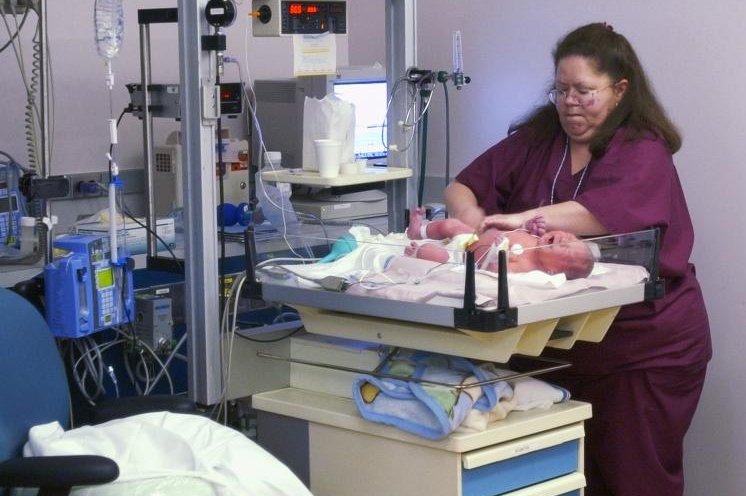Study: Tiny infants born to White mothers stand best chance of better care
By Judy Packer-Tursman

Very premature infants born to mothers of racial and ethnic minorities are less likely than their White counterparts to receive active medical interventions, such as antibiotic therapy, a new study says.
Photo by Chief Warrant Officer 4 Seth Rossman/U.S. Navy
Aug. 16 (UPI) -- The rate of active medical interventions to save very premature infants increased significantly across the United States from 2014 to 2020, a new study says.
But such infants born to Asian/Pacific Islander, Black and Hispanic mothers were far less likely to receive this care at birth than their non-Hispanic White counterparts.
The researchers defined active treatment as interventions performed in an attempt to treat the infant, "including surfactant therapy, immediate assisted ventilation at birth, assisted ventilation more than six hours in duration and/or antibiotic therapy during the neonatal intensive care unit admission."
That's the gist of research led by Ohio State University published Tuesday in JAMA, the Journal of the American Medical Association.
Aug. 16 (UPI) -- The rate of active medical interventions to save very premature infants increased significantly across the United States from 2014 to 2020, a new study says.
But such infants born to Asian/Pacific Islander, Black and Hispanic mothers were far less likely to receive this care at birth than their non-Hispanic White counterparts.
The researchers defined active treatment as interventions performed in an attempt to treat the infant, "including surfactant therapy, immediate assisted ventilation at birth, assisted ventilation more than six hours in duration and/or antibiotic therapy during the neonatal intensive care unit admission."
That's the gist of research led by Ohio State University published Tuesday in JAMA, the Journal of the American Medical Association.
The study focused on extremely low birthweight infants, born before the third trimester of pregnancy, known medically as "periviable."
Only 4 of every 1,000 infants delivered in the United States in 2015 were born between 22 weeks, zero days and 25 weeks, six days gestation, the research paper said.
But these births accounted for roughly 40% of all neonatal deaths, the researchers said, and fully two-thirds of periviable infants were born to a mother who identified as either non-Hispanic Black or Hispanic in 2019.
The investigators reviewed data from the National Center for Health Statistics and found nearly 62,000 "periviable" babies, born alive and without congenital disorders between 2014 and 2020.
Of these births, 37% were Black, 34% white, 24% Hispanic and 5% Asian/Pacific Islander.
Overall, periviable births represented 0.2% of the nearly 27 million live births over the study's time period: 5% were Asian/Pacific Islander, 37% Black, 24% Hispanic and 34% White. And 14% were born at 22 weeks, 21% at 23 weeks, 30% at 24 weeks, and 34% at 25 weeks.
Just over half of these infants -- 52% -- received active medical treatment.
According to the researchers, there were regional differences in active medical treatment for these infants. For example, they pointed out that the rate of active treatment increased for all groups in the Midwest and South.
The researchers noted the inherent challenges in deciding whether to begin active life-saving treatment for such infants since, even if they survive, there is a high risk of potentially life-long adverse health outcomes.
They cited a recent meta-analysis of infants born at 22 weeks who received active treatment that found 29% of them survived, and only 11% survived without major complications.
The study's findings highlight the need for further research to understand the reasons behind such disparities in neonatal intervention "at the cusp of viability," Dr. Kartik Venkatesh, the study's lead author and a maternal-fetal specialist at Ohio State University's Wexner Medical Center, said in a news release.
In fact, there may be more periviable births in the future, "and at earlier gestational ages, in light of recent changes to laws governing reproductive freedom and choice," said Venkatesh, who also is an assistant professor of obstetrics and gynecology.
He added that it is possible that "persistent racial and ethnic disparities that exist in maternal and neonatal care and outcomes could be worsened in this environment."
Venkatesh said he anticipates the study's findings will spur more clinical and public health strategies to address the problem.
The researchers noted their findings differ from a study of birth certificate data from California, Missouri and Pennsylvania from 1995 to 2005. This earlier data showed that periviable infants of Black and Hispanic individuals were actually more likely to be intubated compared with their White counterparts.
No comments:
Post a Comment